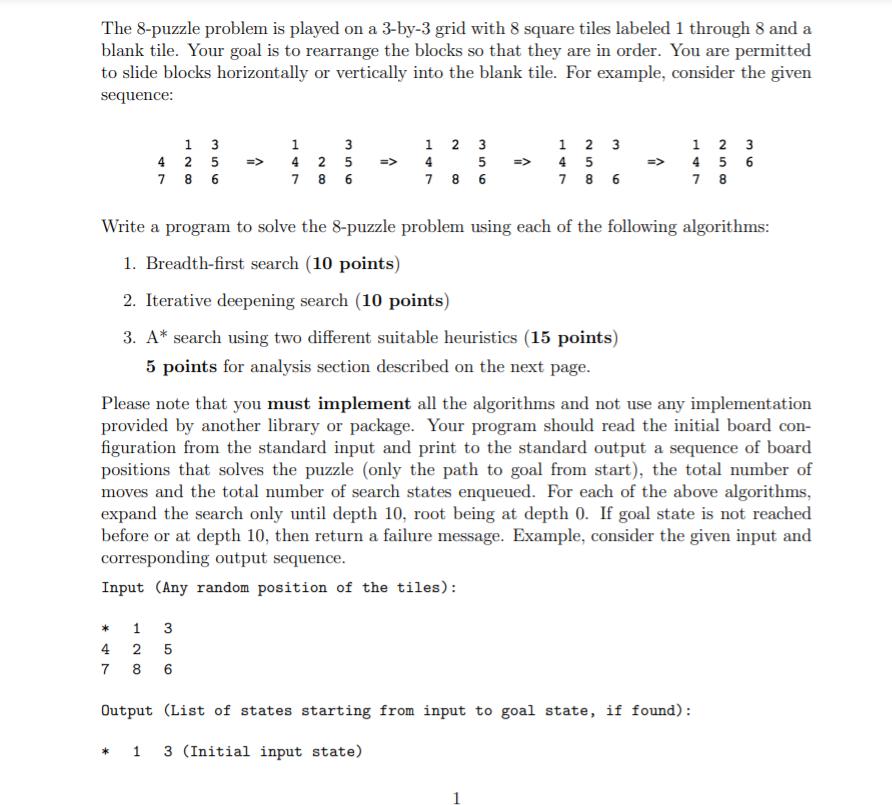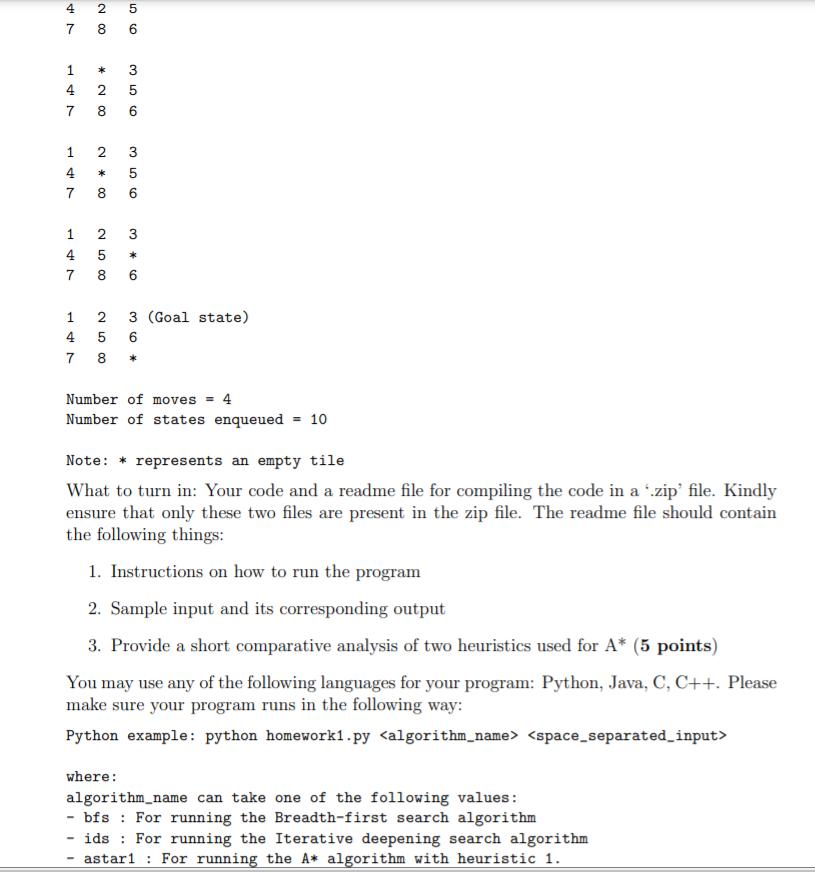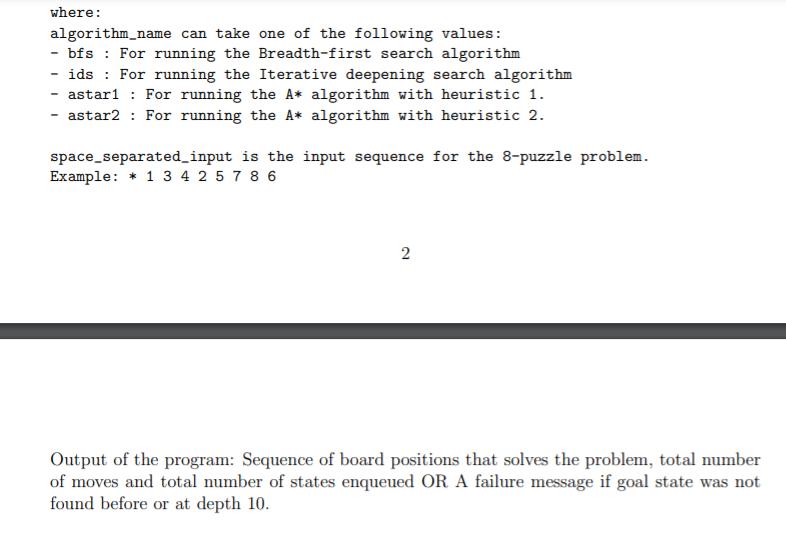Answered step by step
Verified Expert Solution
Question
1 Approved Answer
The 8-puzzle problem is played on a 3-by-3 grid with 8 square tiles labeled 1 through 8 and a blank tile. Your goal is



The 8-puzzle problem is played on a 3-by-3 grid with 8 square tiles labeled 1 through 8 and a blank tile. Your goal is to rearrange the blocks so that they are in order. You are permitted to slide blocks horizontally or vertically into the blank tile. For example, consider the given sequence: 1 2 3 4 5 7 8 6 1 2 3 4 5 6 7 8 1 3 1 3 4 2 5 7 8 6 1 2 3 4 2 5 => => 4 5 => => 7 8 6 7 8 6 Write a program to solve the 8-puzzle problem using each of the following algorithms: 1. Breadth-first search (10 points) 2. Iterative deepening search (10 points) 3. A* search using two different suitable heuristics (15 points) 5 points for analysis section described on the next page. Please note that you must implement all the algorithms and not use any implementation provided by another library or package. Your program should read the initial board con- figuration from the standard input and print to the standard output a sequence of board positions that solves the puzzle (only the path to goal from start), the total number of moves and the total number of search states enqueued. For each of the above algorithms, expand the search only until depth 10, root being at depth 0. If goal state is not reached before or at depth 10, then return a failure message. Example, consider the given input and corresponding output sequence. Input (Any random position of the tiles): * 1 4 7 8 Output (List of states starting from input to goal state, if found): * 1 3 (Initial input state) 4 7 8 6 1 3 4 5 7 6 4 5 7 6 2 3 4 * 7 8 3 (Goal state) 4 6 8 * Number of moves = 4 Number of states enqueued = 10 Note: * represents an empty tile What to turn in: Your code and a readme file for compiling the code in a 'zip' file. Kindly ensure that only these two files are present in the zip file. The readme file should contain the following things: 1. Instructions on how to run the program 2. Sample input and its corresponding output 3. Provide a short comparative analysis of two heuristics used for A* (5 points) You may use any of the following languages for your program: Python, Java, C, C++. Please make sure your program runs in the following way: Python example: python homework1.py where: algorithm_name can take one of the following values: - bfs : For running the Breadth-first search algorithm ids : For running the Iterative deepening search algorithm - astari : For running the A* algorithm with heuristic 1. N 00 * N 00 2 * 00 where: algorithm_name can take one of the following values: - bfs : For running the Breadth-first search algorithm - ids : For running the Iterative deepening search algorithm - astari : For running the A* algorithm with heuristic 1. astar2 : For running the A* algorithm with heuristic 2. space_separated_input is the input sequence for the 8-puzzle problem. Example: * 1 3 4 2 5 7 8 6 2 Output of the program: Sequence of board positions that solves the problem, total number of moves and total number of states enqueued OR A failure message if goal state was not found before or at depth 10. The 8-puzzle problem is played on a 3-by-3 grid with 8 square tiles labeled 1 through 8 and a blank tile. Your goal is to rearrange the blocks so that they are in order. You are permitted to slide blocks horizontally or vertically into the blank tile. For example, consider the given sequence: 1 2 3 4 5 7 8 6 1 2 3 4 5 6 7 8 1 3 1 3 4 2 5 7 8 6 1 2 3 4 2 5 => => 4 5 => => 7 8 6 7 8 6 Write a program to solve the 8-puzzle problem using each of the following algorithms: 1. Breadth-first search (10 points) 2. Iterative deepening search (10 points) 3. A* search using two different suitable heuristics (15 points) 5 points for analysis section described on the next page. Please note that you must implement all the algorithms and not use any implementation provided by another library or package. Your program should read the initial board con- figuration from the standard input and print to the standard output a sequence of board positions that solves the puzzle (only the path to goal from start), the total number of moves and the total number of search states enqueued. For each of the above algorithms, expand the search only until depth 10, root being at depth 0. If goal state is not reached before or at depth 10, then return a failure message. Example, consider the given input and corresponding output sequence. Input (Any random position of the tiles): * 1 4 7 8 Output (List of states starting from input to goal state, if found): * 1 3 (Initial input state) 4 7 8 6 1 3 4 5 7 6 4 5 7 6 2 3 4 * 7 8 3 (Goal state) 4 6 8 * Number of moves = 4 Number of states enqueued = 10 Note: * represents an empty tile What to turn in: Your code and a readme file for compiling the code in a 'zip' file. Kindly ensure that only these two files are present in the zip file. The readme file should contain the following things: 1. Instructions on how to run the program 2. Sample input and its corresponding output 3. Provide a short comparative analysis of two heuristics used for A* (5 points) You may use any of the following languages for your program: Python, Java, C, C++. Please make sure your program runs in the following way: Python example: python homework1.py where: algorithm_name can take one of the following values: - bfs : For running the Breadth-first search algorithm ids : For running the Iterative deepening search algorithm - astari : For running the A* algorithm with heuristic 1. N 00 * N 00 2 * 00 where: algorithm_name can take one of the following values: - bfs : For running the Breadth-first search algorithm - ids : For running the Iterative deepening search algorithm - astari : For running the A* algorithm with heuristic 1. astar2 : For running the A* algorithm with heuristic 2. space_separated_input is the input sequence for the 8-puzzle problem. Example: * 1 3 4 2 5 7 8 6 2 Output of the program: Sequence of board positions that solves the problem, total number of moves and total number of states enqueued OR A failure message if goal state was not found before or at depth 10. The 8-puzzle problem is played on a 3-by-3 grid with 8 square tiles labeled 1 through 8 and a blank tile. Your goal is to rearrange the blocks so that they are in order. You are permitted to slide blocks horizontally or vertically into the blank tile. For example, consider the given sequence: 1 2 3 4 5 7 8 6 1 2 3 4 5 6 7 8 1 3 1 3 4 2 5 7 8 6 1 2 3 4 2 5 => => 4 5 => => 7 8 6 7 8 6 Write a program to solve the 8-puzzle problem using each of the following algorithms: 1. Breadth-first search (10 points) 2. Iterative deepening search (10 points) 3. A* search using two different suitable heuristics (15 points) 5 points for analysis section described on the next page. Please note that you must implement all the algorithms and not use any implementation provided by another library or package. Your program should read the initial board con- figuration from the standard input and print to the standard output a sequence of board positions that solves the puzzle (only the path to goal from start), the total number of moves and the total number of search states enqueued. For each of the above algorithms, expand the search only until depth 10, root being at depth 0. If goal state is not reached before or at depth 10, then return a failure message. Example, consider the given input and corresponding output sequence. Input (Any random position of the tiles): * 1 4 7 8 Output (List of states starting from input to goal state, if found): * 1 3 (Initial input state) 4 7 8 6 1 3 4 5 7 6 4 5 7 6 2 3 4 * 7 8 3 (Goal state) 4 6 8 * Number of moves = 4 Number of states enqueued = 10 Note: * represents an empty tile What to turn in: Your code and a readme file for compiling the code in a 'zip' file. Kindly ensure that only these two files are present in the zip file. The readme file should contain the following things: 1. Instructions on how to run the program 2. Sample input and its corresponding output 3. Provide a short comparative analysis of two heuristics used for A* (5 points) You may use any of the following languages for your program: Python, Java, C, C++. Please make sure your program runs in the following way: Python example: python homework1.py where: algorithm_name can take one of the following values: - bfs : For running the Breadth-first search algorithm ids : For running the Iterative deepening search algorithm - astari : For running the A* algorithm with heuristic 1. N 00 * N 00 2 * 00 where: algorithm_name can take one of the following values: - bfs : For running the Breadth-first search algorithm - ids : For running the Iterative deepening search algorithm - astari : For running the A* algorithm with heuristic 1. astar2 : For running the A* algorithm with heuristic 2. space_separated_input is the input sequence for the 8-puzzle problem. Example: * 1 3 4 2 5 7 8 6 2 Output of the program: Sequence of board positions that solves the problem, total number of moves and total number of states enqueued OR A failure message if goal state was not found before or at depth 10.
Step by Step Solution
★★★★★
3.37 Rating (163 Votes )
There are 3 Steps involved in it
Step: 1
Code is implemented in java as no specific language is mentioned Filename mainjava import javautil public class Main private boolean goalTestList state forint i 0 i 8 i String inputTile stategeti3geti...
Get Instant Access to Expert-Tailored Solutions
See step-by-step solutions with expert insights and AI powered tools for academic success
Step: 2

Step: 3

Ace Your Homework with AI
Get the answers you need in no time with our AI-driven, step-by-step assistance
Get Started


